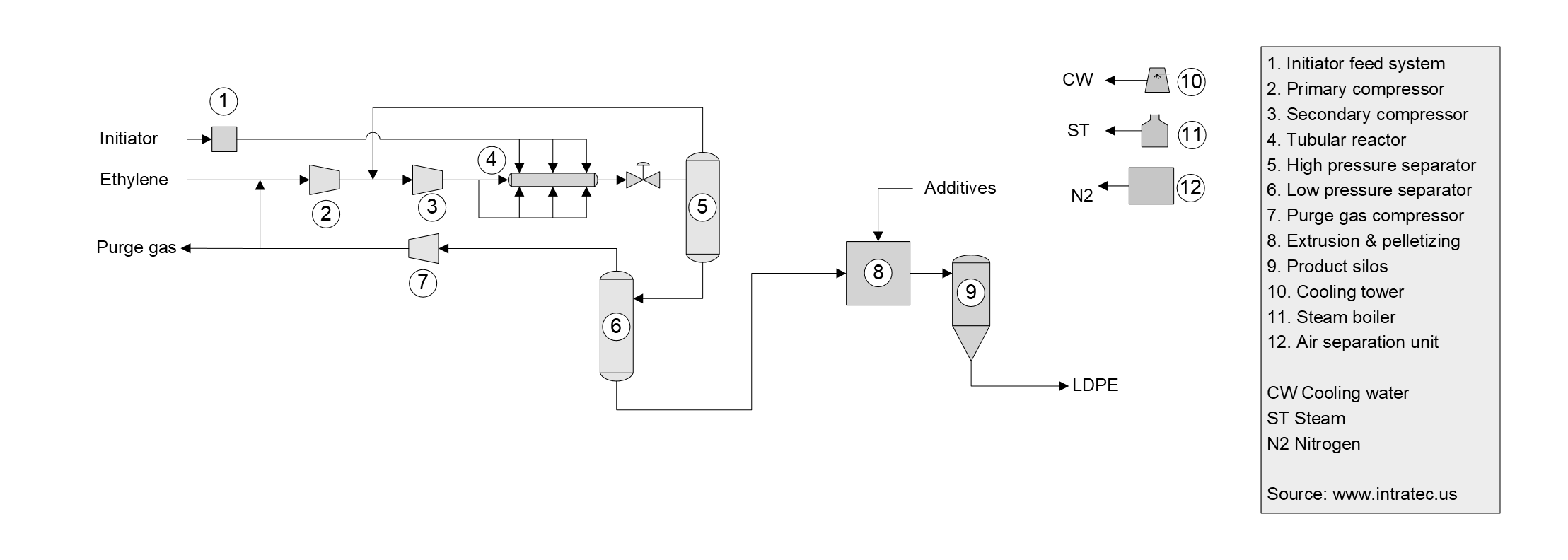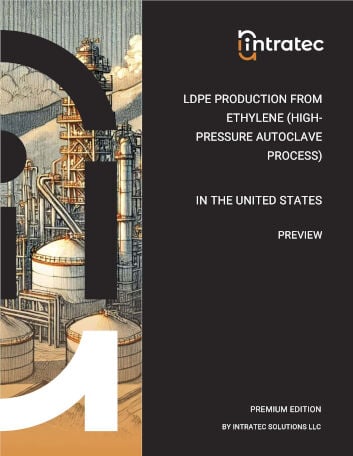Commodity Production Costs Report
LDPE Production from Ethylene (High-Pressure Tubular Process)
LDPE Plant Capital & Operating Cost Analysis | United States | Q3 2025
This report presents the economics of Low Density Polyethylene (LDPE) production from polymer grade (PG) ethylene. The process examined is a typical high-pressure tubular polymerization process. In this plant, PG ethylene is compressed and fed to a tubular reactor, where the polymerization reaction takes place, yielding LDPE.
The report provides a comprehensive study of LDPE production and related LDPE production cost, covering three key aspects: a complete description of the LDPE production process examined; an in-depth analysis of the related LDPE plant capital cost (Capex); and an evaluation of the respective LDPE plant operating costs (Opex).
The LDPE production process description includes a block flow diagram (BFD), an overview of the industrial site installations, detailing both the process unit and the necessary infrastructure, process consumption figures and comprehensive process flow diagrams (PFD). The LDPE plant capital cost analysis breaks down the Capex by plant cost (i.e., ISBL, OSBL and Contingency); owner's cost; working capital; and costs incurred during industrial plant commissioning and start-up. The LDPE plant operating costs analysis covers operating expenses, including variable costs like raw materials and utilities, and fixed costs such as maintenance, labor, and depreciation.
Key reference(s): (1) US Patent 6899852, issued to ExxonMobil in 2005; (2) US Patent 20130333832, issued to LyondellBasell in 2013

The process under analysis comprises four major sections: (1) Compression; (2) Reaction; (3) Separation; and (4) Extrusion & Pelletizing.
Compression. Fresh polymer-grade ethylene is mixed with a low-pressure gas stream, containing unreacted monomer recovered downstream, and fed to the primary compressor where the ethylene is compressed to 300 bar. The ethylene stream from the Primary Compressor is mixed with chain transfer agents and recycled ethylene monomer recovered and fed to the secondary compressor, where it is compressed to 3,000 bar, the reactor operating pressure.
Reaction. The compressed ethylene is divided into several streams, fed to the tubular reactor at different injection points. The organic peroxide solutions from the Initiator feed system, also injected at multiple points along the length of the reactor, initiate the polymerization reaction. The reaction is carried out at high temperatures (220 °C) and high pressures (3,000 bar). Reaction heat is removed by (i) the increase in the temperature of ethylene, (ii) the addition of fresh monomer in side-stream entry points, and (iii) heat transfer through a jacket water cooling system.
Separation. The reactor outlet is expanded to 300 bara and fed to a high-pressure separator, where nonreacted gas is removed from the polymer by adiabatic flash. The molten polymer phase from the bottom of the high-pressure separator is routed to the low pressure separation. Here, the molten polymer phase passes through an additional flash step, in which remaining unreacted ethylene is removed.
Extrusion & Pelletizing. The molten polymer and additives are fed to a short single-screw extruder with an underwater pelletizer. Here the mixture is pelletized and then conveyed to silos for homogenization. The pellets are sent to bagging silos that serve the stationary bagging and packaging lines. Finally, LDPE product is packed in bags.
Report in PDF Format
Download & Explore Anytime
Access in Various Devices
Print & Read Comfortably
Share With Co-workers
Up-to-date Report
Professional report based on Q3 2025 economic data, ensuring timely evaluations.
Multiple Use Cases
Ideal for investment screening, feasibility studies, cost estimates, and research planning.
Proven Methodology
Developed using a consistent methodology honed over a decade, ensuring reliable cost analyses.
Report Editions
Content Highlights
Plant Capital Cost Summary
Summary outlining the capital cost required for building the LDPE production plant examined.
Plant Capital Cost Details
Detailing of fixed capital (ISBL, OSBL & Owner’s Cost), working capital and additional capital requirements.
Plant Cost Breakdowns
Breakdown of LDPE process unit (ISBL) costs and infrastructure (OSBL) costs; plant cost breakdown per discipline.
Operating Costs Summary
Summary presenting the operating variable costs and the total operating cost of the LDPE production plant studied.
Operating Cost Details
Detailing of utilities costs, operating fixed costs and depreciation.
Plant Capacity Assessment
Comparative analysis of capital investment and operating costs for different LDPE plant capacities.
Production Process Information
Block Flow Diagram, descriptions of process unit (ISBL) and site infrastructure (OSBL).
Process Consumptions
Raw materials and utilities consumption figures, by-products credits, labor requirements
Process Diagrams
Process flow diagrams (PFD), equipment list and industrial site configuration
Other LDPE Production Cost Reports

LDPE Production from Ethylene (High-Pressure Autoclave Process)
This report analyses the economics of a typical Low Density Polyethylene (LDPE) production process from polymer grade (PG) ethylene in the United States. The process examined in this report is a high-pressure autoclave process.
Details: 150 kta United States-based plant | Q3 2025 | 107 pages | Issue B | From $799 USD
Bundle & Save
Purchase multiple LDPE Production Cost reports and enjoy tiered discounts
up to 20% off!
Could Not Find the Report You Need?
Obtain a Bespoke Report
Get a report targeting the process in which you are interested
See Offer Details
Understand Bespoke Reports and how you can easily order them
Check Editions & Pricing
Complete a brief form and see a quotation for your Bespoke Report
Other Related Production Cost Reports

Ethylene Production from Ethane
This report presents the economics of Polymer Grade (PG) Ethylene production from ethane in the United States. In the process under analysis, ethane is thermally cracked in pyrolysis furnaces through the use of steam, yielding Ethylene. A hydrogen-rich gas is generated as by-product.
Details: 1200 kta United States-based plant | Q3 2025 | 107 pages | Issue B | From $799 USD

Ethylene Production from Naphtha (Low Severity Steam Cracking)
This report presents the economics of a naphtha-based steam cracker, equipped with an electricity cogeneration unit. In this process, naphtha is thermally cracked at low severity conditions, maximizing propylene to Ethylene ratio. The analysis is based on a plant located in Germany.
Details: 800 kta Germany-based plant | Q3 2025 | 107 pages | Issue A | From $799 USD
+800 Reports Developed, Targeting +250 Commodities
Vast Report Library
858 independent and up-to-date reports examining embryonic and established production processes.
Free Sample Reports
Quickly understand the structure and depth of content of our professional reports.

